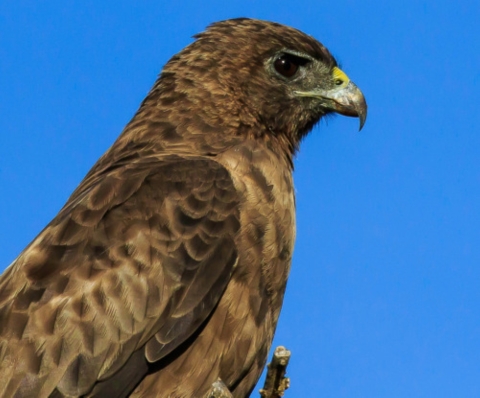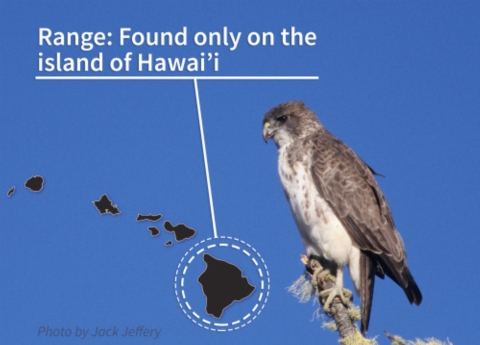Scientific name: Buteo solitarius
Hawaiian name: ʻIo
Common name: Hawaiian Hawk
Status: Endangered
Only one hawk lives and hunts in the forests of the Hawaiian islands. The ‘io. A small, broad-winged raptor found nowhere else in the world. The ‘io once flew on six of the Hawaiian islands, but today is only found on the island of Hawaii, the largest and youngest island in the Hawaiian archipelago.
In traditional Hawaiian culture, ‘io are considered a symbol of Hawaiian royalty because of their lofty flight, and they are believed to be an “‘aumakua” – a family or personal god in the shape of an animal. Mortals did not harm or eat ‘aumakua, and in return, the ‘aumakua would warn and reprimand mortals in their dreams, visions and calls.
The ‘io is only 16 to 18 inches in length - like most hawk species, the females are slightly larger - with two distinct color phases. The dark phase or morph ‘io has a dark brown head, breast, and underwings, while the light color morph has a dark head with a light breast and light underwings. It’s feet and legs are yellowish in adults and greenish in juveniles.
Habitat and Range
Currently, the hawk is known to breed only on the island of Hawai‘i, but there have been at least eight observations of the species on the islands of Kaua‘i, O‘ahu, and Maui since 1978, and fossils are known from the islands of Moloka‘i and Kaua‘i.
The current range of the hawk is estimated to encompass 2,372 square miles, comprising 58.7 percent of the island of Hawai‘i. ‘Io are quite territorial and will vigorously defend the areas around their nest and hunting range.
They have been known to nest in a variety of native and non-native habitats, but they can be found in much higher densities and have higher reproductive success in native ohia forests.
Diet and Life Cycle
‘Io begin breeding around age 3 or 4 and will mate for life. The males will perform acrobatic courtship displays that can be seen from winter through the spring, when nesting season begins. The pair begins nest building in the spring and continues until the females lay their clutch usually of 1-2 eggs.
Egg laying begins in March and hatching is typically done by July. Both parents help with incubating the egg for 38 days, but once the chick has hatched the male primarily hunts while the female broods.
The ‘io is an opportunistic feeder, and will hunt a wide variety of prey. Prior to the introduction of land mammals to the islands, the ‘io probably hunted birds as their main source of food. Today rats, mice, mongoose and various bird species are all significant parts of the ‘io diet.
‘Io hunt and nest in a wide variety of habitats. While they generally prefer dense native forests, they are also frequently seen in agricultural areas as well.
Threats to the Species
The Hawaiian Hawk was listed as endangered in 1967. Since that time the population has remained low, but relatively stable. However, habitat loss due to invasive plants and the spread of rapid ohia death continue to be a threat to the species.
Reason for Hope
The establishment of the Hakalau Forest NWR (north Hilo region) in 1985, the Kona Forest Unit of the Hakalau Forest NWR in 1997, and The Nature Conservancy’s Kona Hema Preserve (south Kona region) between 1999 and 2003 have all added important protected habitat for the ‘io.
The Hakalau Unit of the Hakalau NWR was established with the primary purpose of promoting the recovery of endangered forest birds and their habitat. There have also been several projects undertaken at Hawai’i Volcanoes National Park and on private lands on the island of Hawai’i aimed at native forest conservation that have likely benefited the ‘io overall.
###
The U.S. Fish and Wildlife Service works with others to conserve, protect, and enhance fish, wildlife, plants, and their habitats for the continuing benefit of the American people. For more information, visit www.fws.gov/pacificislands, or connect with us through any of these social media channels at https://www.facebook.com/PacificIslandsFWS, www.flickr.com/photos/usfwspacific/, https://medium.com/usfwspacificislands or www.twitter.com/USFWSPacific.






